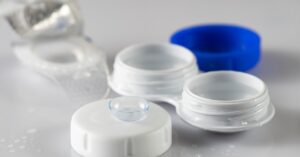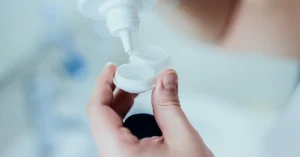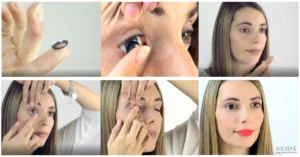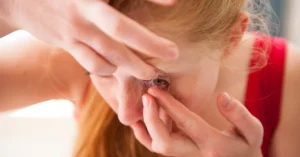Confirming the Presence of Contact Lens
Before proceeding with any activities or removing your contact lenses, it is crucial to confirm the presence of contact lens in your eye. By doing so, you can avoid potential discomfort, prevent damage to your eye, and ensure the safe handling of your contact lenses. Let’s explore the importance of confirming the presence of a contact lens and the signs to look for to determine if the lens is still in your eye.
Importance of Confirming the Presence of Contact Lens
Confirming the presence of your contact lens is essential to maintain optimal eye health and prevent any potential complications. If you mistakenly assume that your contact lens is not in your eye when it actually is, you may risk inserting another lens on top of the existing one, which can lead to discomfort, blurred vision, or even eye infections. On the other hand, if you assume the lens is still in your eye when it has fallen out, you may inadvertently touch or rub your eye, which can cause irritation or abrasions.
To ensure the continued comfort and safety of your eyes, it is crucial to confirm whether your contact lens is still in your eye before proceeding with any further activities or removing the lens.
Signs to Look for if Contact Lens is Still in Your Eye
To determine if your contact lens is still in your eye, there are several signs you can look for:
- Visual Clarity: If your vision remains clear and you can see adequately without any blurriness or discomfort, this may indicate that your contact lens is still in place.
- Sensation: Pay attention to any discomfort or foreign body sensation in your eye. If you experience discomfort, excessive dryness, or irritation, it may suggest that your contact lens is no longer in your eye.
- Eye Movement: Observe your eye movement. If you can move your eyes freely without feeling the contact lens shifting or moving around, it is likely that the lens is still in place.
- Blinking: Blinking can help you determine if the contact lens is present. If you feel the lens moving or shifting upon blinking, it may indicate that it is not in the correct position or has fallen out.
Remember, if you are having difficulty confirming the presence of your contact lens or if you suspect it is no longer in your eye, it is best to seek assistance from an eye care professional. They can provide guidance and ensure the proper care of your eyes and contact lenses.
By understanding the importance of confirming the presence of your contact lens and being aware of the signs to look for, you can confidently proceed with your activities while maintaining the health and comfort of your eyes.
Step-by-Step Guide to Confirming Contact Lens Presence
To ensure that your contact lens is still in your eye, follow this step-by-step guide for a thorough confirmation.
Wash Your Hands Thoroughly
Before attempting to check for the presence of your contact lens, it is important to wash your hands thoroughly. Use mild soap and warm water to clean your hands, making sure to remove any dirt or debris that may be present. This step helps to minimize the risk of introducing any foreign particles into your eye and ensures a hygienic examination.
Positioning Your Eye Correctly
Once your hands are clean, position yourself in front of a well-lit mirror. Tilt your head slightly backward and look straight ahead. This positioning allows for a clear view of your eyes and facilitates a more accurate assessment of your contact lens.
Use a Mirror for Visual Confirmation
Using your index finger, gently lift your upper eyelid while looking down. This creates a clear line of sight to your lower eyelid. Similarly, use your middle finger to lift your lower eyelid while looking up. By exposing the entire surface of your eye, you can visually inspect for the presence of your contact lens.
While examining your eye, pay close attention to any signs of the contact lens, such as a slight tint or edge. If you are unable to locate the lens, it is possible that it may have shifted or fallen out. In such cases, refer to our article on how to remove contact lenses for proper guidance.
Remember, if you are experiencing any discomfort or irritation, it is important to consult with an eye care professional for further assistance. They can provide valuable insights and recommendations specific to your situation.
By following these steps, you can effectively confirm whether your contact lens is still in your eye. If you have any concerns or difficulties, do not hesitate to seek professional help. For more information on contact lens care, visit our article on how to clean contact lenses.
Additional Methods for Confirming Contact Lens Presence
In addition to the step-by-step guide, there are a few additional methods you can employ to ensure the presence of your contact lens in your eye. These methods can provide further reassurance and help you determine if your contact lens is still in place.
Blinking and Blinking Exercises
Blinking is a natural reflex that can help you confirm if your contact lens is still in your eye. By blinking a few times, you can assess whether you feel any discomfort or if the lens moves or dislodges. If your contact lens is properly positioned, blinking should not cause any significant changes in comfort or clarity of vision.
Blinking exercises can also be useful in confirming the presence of your contact lens. You can try performing a series of rapid blinks followed by a few slow, deliberate blinks. This can help redistribute the tear film and ensure the contact lens is properly centered on your eye. If you experience any discomfort or notice a change in vision during these exercises, it may indicate that your contact lens is not properly in place. In such cases, follow the step-by-step guide or consider seeking assistance from an eye care professional.
Utilizing Eye Drops to Assess Lens Presence
Using lubricating eye drops can be another effective method to confirm if your contact lens is still in your eye. Apply a few drops of preservative-free lubricating eye drops to your eyes, ensuring that the drops come into contact with the surface of your contact lens. Blink a few times to distribute the eye drops evenly.
If your contact lens is properly in place, the eye drops should adhere to the lens and provide immediate relief from dryness or discomfort. If you experience difficulty in finding or feeling the contact lens even after using the eye drops, it may indicate that the lens is not in your eye. Follow the step-by-step guide or consult an eye care professional for further assistance.
Seeking Assistance from an Eye Care Professional
If you have followed the step-by-step guide and additional methods but are still unsure about the presence of your contact lens, it is advisable to seek assistance from an eye care professional. They have the expertise and tools to thoroughly examine your eye and ensure that your contact lens is properly positioned. They can also provide guidance on proper contact lens insertion and removal techniques to prevent future concerns.
Remember, if you experience discomfort, redness, or any other unusual symptoms while wearing contact lenses, it is essential to consult an eye care professional promptly. They can address any potential issues and provide tailored guidance based on your specific situation.
By utilizing these additional methods, you can gain further assurance about the presence of your contact lens in your eye. Regularly practicing proper contact lens care techniques, such as cleaning and disinfection, can also help ensure optimal comfort and safety. For more information on how to clean your contact lenses effectively, refer to our article on how to clean contact lenses.
Troubleshooting Tips
While confirming if your contact lens is still in your eye is essential, there may be instances where you encounter certain issues or discomfort. Here are some troubleshooting tips to help you navigate such situations:
When You Cannot Find Your Contact Lens
Sometimes, despite your best efforts, you may have difficulty locating your contact lens. If this happens, don’t panic. Try the following steps:
- Remain calm: Take a deep breath and try to relax. Panicking can make it more challenging to find the lens.
- Double-check: Revisit the steps outlined in the step-by-step guide to ensure you haven’t missed anything.
- Check your surroundings: Look around the area where you last removed or inserted your contact lens. It may have fallen on a surface or floor.
- Utilize a flashlight: Shine a flashlight around the area to help you locate the lens more easily.
- Consider assistance: If you’re unable to find your contact lens, it may be necessary to seek assistance from an eye care professional. They can provide guidance and perform a thorough examination if needed.
Dealing with Discomfort or Irritation
Sometimes, you may experience discomfort or irritation while wearing contact lenses. If this occurs, follow these steps:
- Remove the lens: If you experience persistent discomfort or irritation, it’s important to remove the contact lens. Refer to our article on how to remove contact lenses for detailed instructions.
- Inspect the lens: Once you’ve removed the lens, examine it for any visible damage or debris. If the lens appears damaged, discard it and replace it with a new one.
- Clean and disinfect: If the lens appears to be in good condition, clean and disinfect it according to the guidelines provided by your eye care professional. Our article on how to clean contact lenses can offer additional guidance.
- Rest your eyes: Give your eyes a break by refraining from wearing contact lenses for a few hours or switching to glasses temporarily. This can help alleviate discomfort and allow your eyes to recover.
If the discomfort persists or worsens, it’s crucial to seek advice from an eye care professional. They can assess your situation and provide appropriate guidance.
Preventing Contact Lens Loss in the Future
To minimize the chances of losing your contact lenses, consider the following tips:
- Handle with care: Always handle your contact lenses with clean hands to avoid dropping or misplacing them.
- Follow proper removal and insertion techniques: Adhere to the correct procedures for removing and inserting your contact lenses. Our article on how to put in contact lenses can provide helpful instructions.
- Establish a routine: Create a consistent routine for removing, cleaning, and storing your contact lenses. This can help you keep track of your lenses and reduce the risk of misplacing them.
- Store lenses properly: When not in use, store your contact lenses in a clean case with fresh disinfecting solution. Make sure to replace the solution regularly and clean the case thoroughly.
- Avoid exposing lenses to water: Contact lenses should never come into contact with water. Remove your lenses before swimming or showering to prevent them from being washed away or contaminated.
By implementing these tips, you can minimize the chances of contact lens loss and help ensure a smooth and comfortable experience throughout your contact lens journey.

























